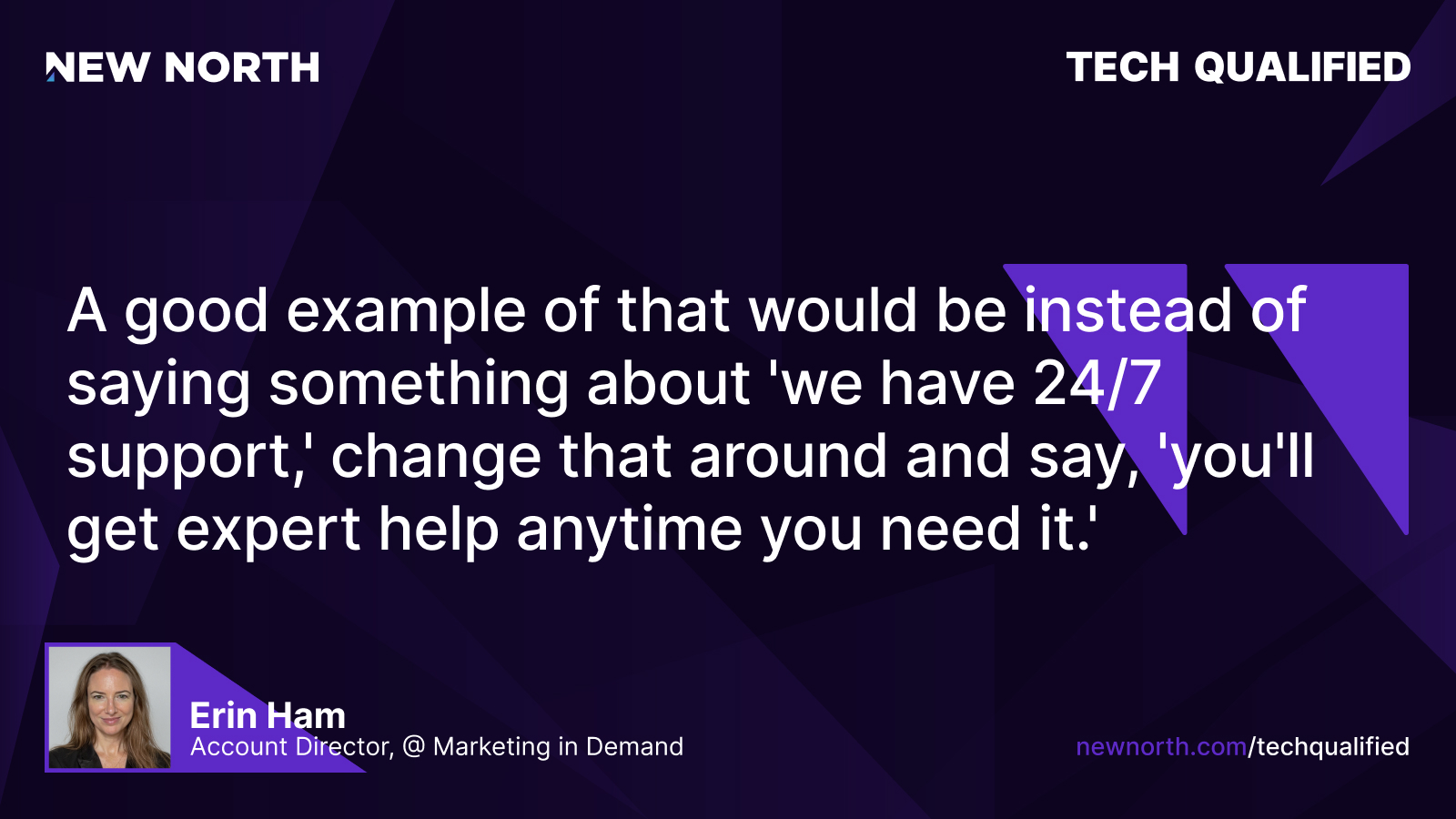Your homepage has one job: prove to your buyer that they’re in the right place.
For B2B tech companies, that moment of judgment happens fast. In five seconds or less, they’re asking themselves: Do these people understand what I need? If the answer isn’t obvious, they bounce.
Too often, tech websites miss the mark. Instead of addressing real buyer concerns, they bury visitors in jargon, brag about awards, or list features no one asked for.
This post is here to help you fix that. You’ll learn four practical steps to build a B2B tech website that puts your customer at the center. We’ll cover what buyers actually look for, how to speak their language, and how to streamline the path from visit to conversion.
By the end, you’ll have a clear framework for making your website not just more informative but more useful for the people who matter most.
1. Pass the Five-Second Test
When someone lands on your site, they’re not reading—they’re scanning. If they can’t understand what you do or who you help within five seconds, they’re gone. That moment above the fold is your best shot at earning their attention, and every element needs to pull its weight.
Make Your Message Obvious
Start with a headline that speaks directly to your customer’s goal or pain point. Avoid buzzwords, vague language, or clever phrases that sound nice but say nothing. A headline like “Automated compliance monitoring for SaaS teams” works because it’s clear, specific, and immediately relevant.
Follow it up with a subhead explaining the problem you solve practically. For example: “Never miss an audit deadline or scramble to find your data again.”
Then, guide the visitor forward with one clear, focused call to action. Make it visible above the fold. Keep it simple—something like:
- Book a Demo
- Start Your Free Assessment
- See the Platform
Avoid stacking multiple CTAs. More options just increase friction.
Validate with the Five-Second Test
Test your homepage on someone unfamiliar with your brand—ideally, someone similar to your ideal customer. Give them five seconds. Then ask: Can you tell what this company offers and why it matters?
If they hesitate or misinterpret the value, revise. Repeat. Keep refining until the answer is crystal clear.
The five-second test helps you remove assumptions and focus on what resonates. When your message lands at first glance, your site starts doing what it should: convert.
2. Shift to Customer-Centric Messaging
Many B2B tech websites default to company-first messaging—highlighting awards, listing every feature, or telling a long-winded brand story. But buyers don’t come to your site to learn your backstory. They’re there to solve a problem.
Flip the Script: Make It About the Buyer

Take a look at your copy. If it’s filled with “we,” “our,” and “us,” it’s time to shift the focus. Change “We offer 24/7 support” to “You get expert help anytime you need it.” That change creates instant relevance.
Speak to outcomes instead of listing features. Buyers want to know what they’ll gain. “Advanced analytics dashboard” doesn’t mean much on its own. “Catch revenue leaks before they hurt your margins” gets attention.
Cut the Jargon, Back It Up
Avoid abstract phrases like “streamline digital innovation.” Be direct. For example: “Automate reporting and eliminate manual work.”
Then, ground your claims with proof. A short quote from a real customer can do more than any bullet list. For instance:
“With [Your Company], we reduced onboarding time from three weeks to three days.”
Make your website a place where buyers see their challenges reflected and resolved. When they see clear value and relatable outcomes, they’re more likely to engage.
3. Simplify Navigation and Minimize Decision Fatigue
When your site overwhelms visitors with options, they hesitate or leave. Clear, simple navigation helps buyers move forward with confidence. The goal is to reduce friction and guide them toward action.
Limit Choices, Guide the Journey
Stick to three to four main menu items. Prioritize labels that reflect the buyer’s intent, not your internal structure. Instead of generic categories like “Products” or “Resources,” use phrasing that nudges action—labels like “How It Works,” “Customer Results,” or “Start Your Trial” move visitors toward a decision.
Each page should have one clear purpose. Avoid competing CTAs, bloated nav menus, and dead-end links. Give people fewer decisions, and they’ll make more of them.
Remove Friction, Add Cues
Do a quick audit. Which pages drive real value? Which just adds noise? Trim what doesn’t support conversion.
Use sticky navigation so your main CTA is always visible. Add small directional cues like arrows or high-contrast buttons to highlight the next step. These visual signals help visitors know where to go, even if they’re skimming.
The simpler the path, the easier the progress. Clean navigation builds trust, and trust is what motivates your buyer to take action.
4. Collaborate with Sales for Messaging
Sales teams hear buyer concerns in real time. They know which objections come up most, which benefits resonate, and which phrases signal a ready-to-buy prospect.
Bring Sales In Early
Don’t wait until the site is live to be able to loop in sales. Start by gathering the questions they hear on calls, the objections that stall deals, and the lines that consistently move conversations forward.
Ask sales what buyers care about most. What frustrates them? What features do they ask for repeatedly? What specific promise makes them say “Let’s talk”? Use those insights to build copy that connects.
Use Real Buyer Language
Sales calls are full of phrases buyers use. Capture those. Instead of writing from a product roadmap, lead with the buyer’s words.
Language borrowed from real conversations feels familiar and relevant. That familiarity earns trust.
Check Back with Closed-Won Deals
After launch, keep the feedback loop open. Sit down with sales and walk through recent wins. What parts of the site helped close the deal? What confused prospects or required extra explanation?
Use these insights to refine your copy, tighten CTAs, and test new ideas. The more you align with what buyers respond to in conversations, the more your site becomes a true driver of pipeline.
Transform Your Website into a Growth Engine
A strong B2B tech website doesn’t win by being flashy—it wins by being useful. When your messaging is clear, your navigation is intuitive, and your copy speaks to real buyer needs, your site starts becoming a pipeline driver.
If you’re ready to align your website with what your buyers actually care about, let’s talk. At New North, we help B2B tech teams turn their websites into engines of growth—built around real business outcomes, not vanity metrics. Reach out to see how we can help you translate clicks into a qualified pipeline.
Frequently Asked Questions
What makes a website “customer-centric” in B2B tech?
A customer-centric website is designed around the needs, questions, and decision-making process of the buyer—not your internal structure. It highlights outcomes, speaks in the buyer’s language, and removes friction from the path to conversion.
How do I know if my homepage passes the five-second test?
Ask someone unfamiliar with your brand to scan your homepage for five seconds. Can they tell what you offer, who it’s for, and what to do next? If not, it’s time to revise your messaging above the fold.
Why should sales have a say in our website copy?
Sales teams hear objections and questions directly from buyers. Their input helps shape messaging grounded in real conversations—not assumptions—making your site more persuasive and aligned with what actually drives deals.
How much content should I cut from my current site?
Focus on impact. If a page doesn’t support a clear buyer need or conversion path, it’s a candidate for removal or consolidation. Fewer, better pages typically outperform large, unfocused sites.
Can SEO and buyer-friendly copy coexist?
Absolutely. Writing for humans first—using clear, relevant language that answers real questions—is what Google wants too. Prioritize clarity and usefulness, and your rankings will benefit as well.
How can New North help us turn our website into a growth engine?
We specialize in helping B2B tech companies create websites that drive qualified pipeline—not just traffic. If you’re ready to align your messaging, structure, and content strategy with what your buyers care about, schedule a call with our team to get started.







